How to identify and care for mantella frogs.
Peering through a small aquarium’s water-stained glass, I spotted what I had saved my allowance for weeks to buy. A tiny frog poked its head out from a pile of moss in the corner and hopped toward the front of the tank chasing an unsuspecting cricket. This beauty was the lone orange frog of several assorted mantellas this local pet store had left. I brought it home and placed it into a heavily planted terrarium. Then I sat down in front of the enclosure and eagerly watched as the frog explored its new surroundings.
That was 1996. It was my introduction to the genus Mantella, a fascinating group of frogs endemic to the island of Madagascar. With their bright aposematic coloration and diurnal behavior, mantellas have become popular vivarium subjects.
It’s a thrill to watch a group of them interact. Males wrestle each other over territory or call from atop leaf litter in the cage. Not only is their captive behavior interesting but also their natural history. Get to know these unique amphibians and you, too, will likely become passionate about the poison frogs of Madagascar.
Mantella Natural History
The island of Madagascar is home to more than 220 species of frogs found nowhere else in the world, including the 16 described Mantella species. Most live in the eastern tropical forests, but species also inhabit drier regions in the western half of the island. Some, such as M. ebenaui, are adaptable and reside in dry woods, rain forests and degraded habitat within their range, but most mantellas are specific to where they live and have small restricted distributions.
Mantellas are most active during the wettest time of year: December to February. During this time males call loudly to defend territory, and females feed on ants, mites and other small invertebrates in preparation for breeding.
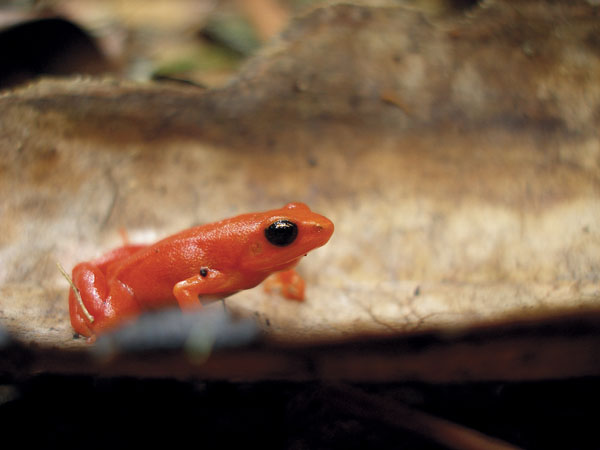
Photo Credit: Devin Edmonds
The island of Madagascar is home to more than 220 species of frogs found nowhere else in the world, including the 16 described Mantella species. Mantella aurantiaca.
Most species breed near streams. Eggs are laid nearby on land, usually in moist depressions. The water from heavy rain then flushes the developing tadpoles into nearby pools of water.
When the rain stops and the cooler dry months follow, mantellas become less active. The severity of this dry season varies in different parts of Madagascar. Some mantellas, such as M. milotympanum, aestivate in extreme conditions until the weather improves; others simply become less visible and live among leaf litter on the forest floor waiting for rain to return.
Sadly, 10 of the 16 Mantella species are considered threatened with extinction by the World Conservation Union because of their small distribution and declining populations. Habitat destruction is the largest problem facing the genus as agriculture, logging, charcoal production and livestock grazing eat away at the last mantella habitats. Collection of frogs for the pet trade has also notably affected these frogs.
The Difference Between Dendrobatidae and Mantella Poison Frogs
Often associated with the similarly small and colorful South American poison frogs of the Dendrobatidae family, mantellas also possess poisonous alkaloids in their skin. However, mantellas seem to loose their toxicity in captivity over time. Although not very dangerous to humans, contact with the frogs should be avoided.
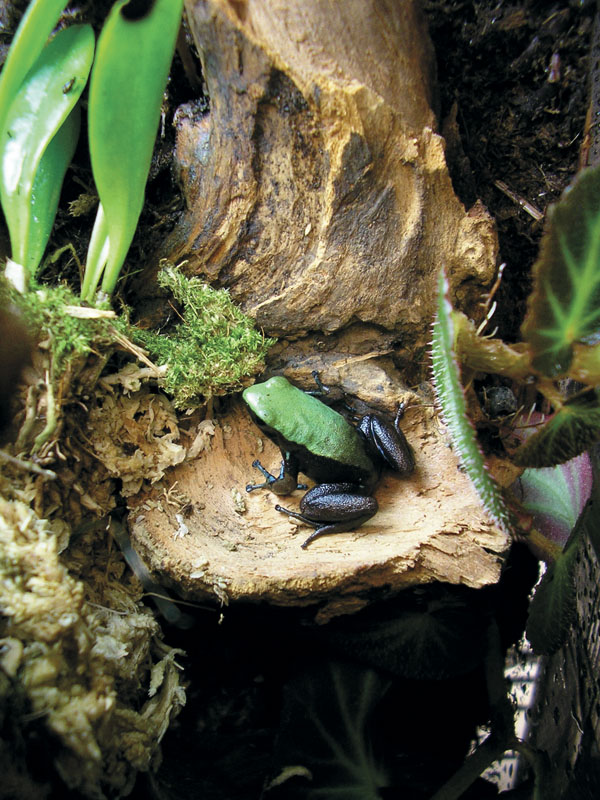
Photo Credit: Devin Edmonds
Mantella laevigata is the only nonterrestrial mantella. Its enlarged toe pads enable it to climb into small tree holes and bamboo wells, where they breed.
One mantella species, M. laevigata, also shares the trait of providing parental care in common with dendrobatids. Mantella laevigata females feed infertile eggs to their tadpoles to ensure they get the food they need.
Although they share many things in common with dendrobatids, mantellas are not closely related to them. They are placed within the anuran subfamily Mantellinae. Their taxonomy seems to constantly be under revision, and it has changed considerably during the past two decades. Currently, there are 16 recognized species. Many other mantellas appearing different from the described species exist, but work still needs to be done in order to determine their official status.
Pick Your Poison Frog
Of all Madagascar’s frogs, Mantella aurantiaca is the most recognized. Varying in shades of orange and red, they are hardy in captivity when provided with cool conditions, meaning the temperature in their enclosure rarely rises above 75 degrees Fahrenheit. They live in several swamp forests in east-central Madagascar, and adults measure between 0.8 and 1.2 inches. At this time they are not exported for the pet trade, but captive-bred frogs are periodically available from breeders and dealers.
Once thought to be a color variety of M. aurantiaca, M. milotympanum can be distinguished by its smaller size (usually 0.7 to 0.9 inches), granular skin and black tympanums. The species is only known to occur in several pockets of gallery forest near swamps, and it’s also critically endangered, yet it still sporadically appears in the pet trade. Golden and lime-green frogs exist, which otherwise appear identical to M. milotympanum, but await further research.
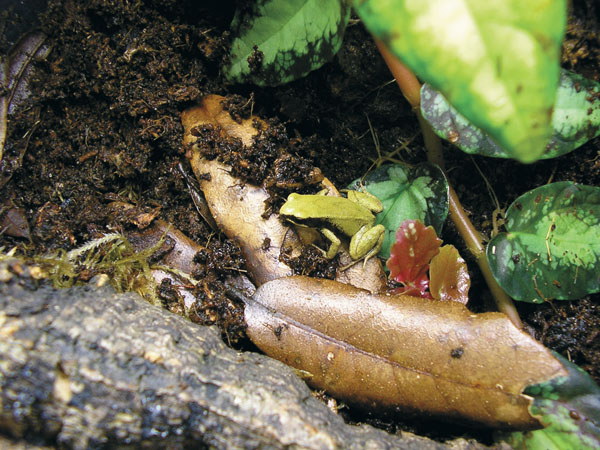
Photo Credit: Devin Edmonds
Female M. crocea grow close to an inch in length, but males may mature at only 0.7 inches.
Closely related to M. milotympanum is M. crocea. Colored yellow, khaki-brown or bronze, the frog’s monotone color is broken by a chocolate face mask, and often brown speckling on the dorsum and limbs. Female M. crocea grow close to an inch in length, but males may mature at only 0.7 inches. These frogs have a tiny distribution, and inhabit forests similar to and near those of M. aurantiaca and M. milotympanum in east-central Madagascar. In captivity, they are hardy as long as they are not exposed to temperatures above the mid to high 70s.
Two other mantella frogs largely brown in color are M. betsileo and M. ebenaui. The two appear nearly identical with russet to copper-colored backs, black flanks and grayish limbs. Both grow to about 0.8 inches long. It’s not possible to tell them apart based on appearance alone. Mantella ebenaui lives in lowland rain forests, tree plantations and human-altered forests in the north of the island. Mantella betsileo occurs farther south with few known populations. At this time, all brown mantellas found for sale are normally sold as M. betsileo, but I speculate that many are in fact M. ebenaui.
Also confusingly similar in appearance are the two painted mantellas: M. baroni and M. madagascariensis. Dorsally, both have elegant lime-green blotches where their limbs attach to their bodies, and these blotches contrast with their black dorsum and striking orange and black legs.
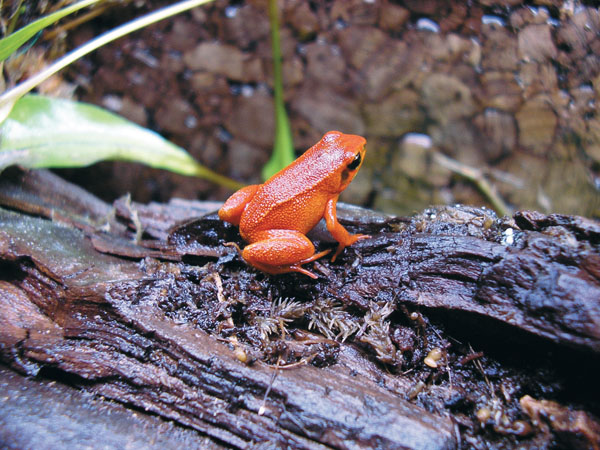
Photo Credit: Devin Edmonds
Once thought to be a color variety of M. aurantiaca, M. milotympanum can be distinguished by its smaller size (usually 0.7 to 0.9 inches), granular skin and black tympanums.
This beautiful pattern is present on both species though they are not closely related. To tell the two apart, examine their throats. Mantella madagascariensis has a sky-blue, horseshoe-shaped marking. Mantella baroni has a single dot or solid-black throat. Additionally, the red on the limbs of M. madagascariensis extends fully through its thighs, but the color stops at the joint on M. baroni.
Mantella baroni grows to between 0.9 and 1.2 inches in length, and a mature M. madagascariensis is between 0.8 and 1.1 inches. Although M. baroni has a large distribution throughout the remaining forests in eastern Madagascar, M. madagascariensis has a smaller range and is confined to primary rain forest. Both species are often found near streams and exist sympatrically in at least one location. Both are rarely bred in captivity, and imports are frequently mixed up together under the all-inclusive common name “painted mantella.”
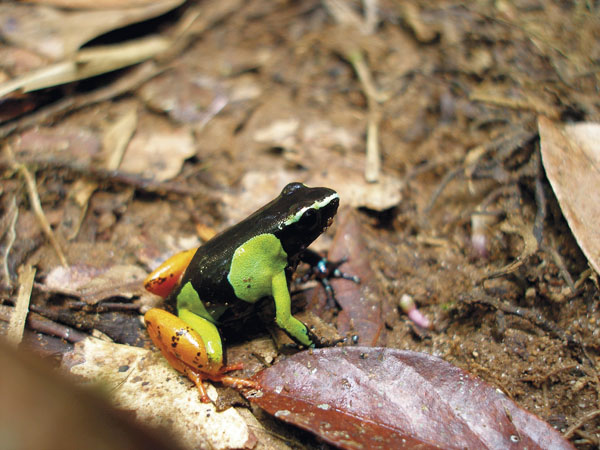
Photo Credit: Devin Edmonds
Mantella baroni grows to between 0.9 and 1.2 inches in length.
A third frog sometimes confused with the two painted mantellas is M. pulchra. Although somewhat variable in the wild, most imported frogs of this species look like a messy, faded version of M. madagascariensis with the contrasting orange and black legs replaced by a pattern of browns. Brown is also present on the dorsum and usually fades to light tan at the very tip of the head. Mantella pulchra measures between 0.8 and 1 inch, and it lives in moist forests in northeastern Madagascar often near streams or swamps. They have a reputation for being rather shy in captivity, but they gladly come out in the open when offered food.
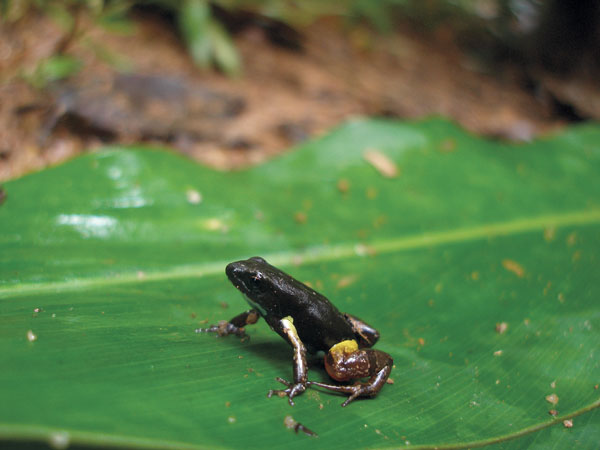
Photo Credit: Devin Edmonds
Mantella bernhardi is the smallest mantella, ranging between three-fourths and 1 inch in length.
The most remarkably patterned mantella is M. cowani, which is dressed in black and contrasting neon red, orange or yellow. These frogs reach between 0.9 and 1.1 inches in length. Their eye-catching patterns fueled a demand for the species far greater than its dwindling wild populations could support, and in 2003 all exports were fortunately stopped. Habitat destruction also has taken a large toll on M. cowani, and it is now confined to small strips of forest along streams in the central highlands. In captivity, the frog is sensitive to even moderately warm temperatures. Some people report frequent exposure to temperatures above 70 degrees can cause heat stress and death. For this reason, M. cowani must be kept in a cool basement or air-conditioned room.
Opposite the striking appearance of M. cowani is the mildly patterned M. bernhardi. Mainly black with hints of gray on the head, this is the smallest mantella species. It often only grows to 0.7 of an inch in length. It has a unique trill-like call, consisting of several clicks strung together. All other male mantellas produce one or two notes. Only a handful of M. bernhardi populations are known to occur in lowland rain forests of southeast Madagascar.
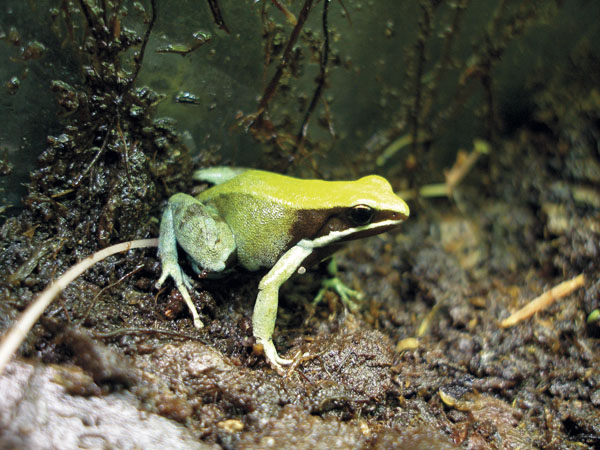
Photo Credit: Devin Edmonds
The largest of the mantellas, Mantella viridis can reach up to 1.2 inches in length.
The big daddy of mantella frogs is M. viridis. The species can reach 1.2 inches and has a stocky, robust body structure. Similar to that of M. crocea, its pattern is a solid-green body interrupted by a black face mask. These frogs are restricted to extreme northern Madagascar, where they live near seasonal streams in dry forests. In captivity they can take relatively large food items and greedily devour half-inch-long crickets.
One highly prized species is M. expectata. It displays remarkable sky-blue legs and a contrasting lemon-yellow dorsum. These frogs measure between 0.8 and 1 inch in length. In captivity, my group displays these attractive colors when kept in drier conditions. When exposed to a simulated rainy season, they fade to a less attractive steel-blue and mustard-yellow. Mantella expectata is limited to the dry southwest of Madagascar mostly near seasonal streams and rocky canyons.
One mantella appearing in the pet trade in the recent past is often sold as a color variety of M. expectata or under the common name “blushing mantella.” These frogs have markings similar to M. expectata, but the yellow of the dorsum is replaced by an orange that fades to deep crimson posteriorly. The legs are also different, not blue but gray and sometimes splashed with the same crimson found on the dorsum. The status of this frog’s species remains unclear.
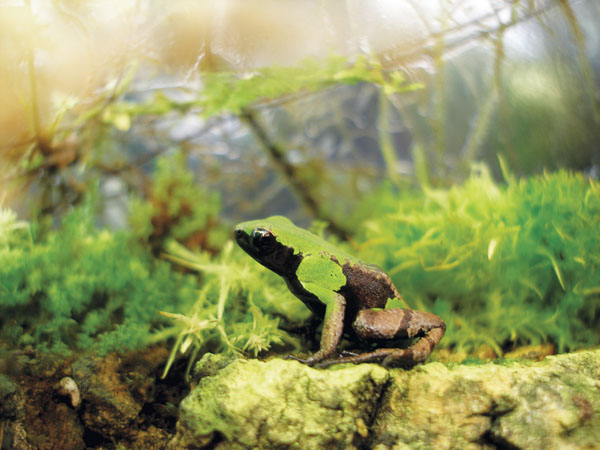
Photo Credit: Devin Edmonds
With a range in northern Madagascar, Mantella nigricans can be found streamside at the forest’s edge.
The only nonterrestrial member of the genus is M. laevigata. With their enlarged toe pads, they can climb to the small tree holes and bamboo wells in which they breed. Mantella laevigata can grow to 1.1 inches in length. Two-tone in pear-green and black, they resemble the closely related M. manery.
Mantella manery differs by having a white frenal stripe and dark-brown body. Described in 1999, only a couple of the frogs have been recorded where they were found in primary forest near a stream.
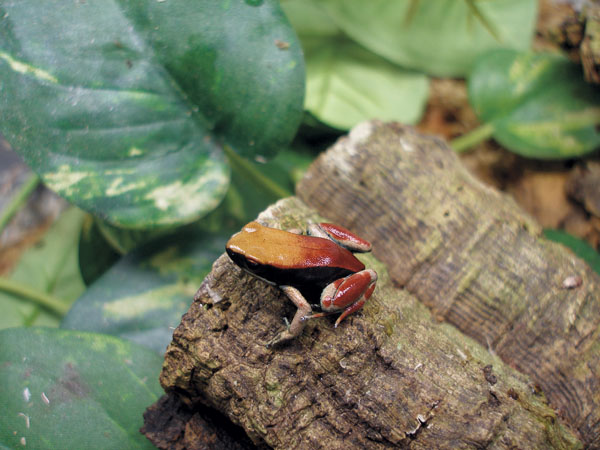
Photo Credit: Devin Edmonds
The “blushing mantella” is sold as a color variety of Mantella expectata, but its status still remains unclear.
Mantella nigricans has a large range in northern Madagascar, but it has only been exported in small numbers and is uncommon in captivity. This frog is a streamside species, living at the forest edge often near water. Colored walnut-brown and lime-green, these frogs appear at first glance like an unusually green M. pulchra. Mantella nigricans grows to 1.1 inches. Particularly bold in captivity, males call relentlessly after feeding or misting with a metallic-sounding chirp.
Lastly, there’s Mantella haraldmeieri. Found in the far southeast of Madagascar, they live in humid rain forests often along streams. Copper-colored hind limbs contrast with the mint-green of their upper forearms and brown body. Mantella haraldmeieri measures between 0.8 and 1.1 inches in length. They are not often seen in captivity.
Wild Caught Woes
Wild mantellas are particularly sensitive when first acquired, and they usually arrive malnourished and with parasites. For this reason, quarantine newly imported frogs for several weeks or months in simple housing. Monitor them carefully, and treat problems with the necessary medication as advised by a veterinarian. After this acclimation period they can be moved to more permanent setups.
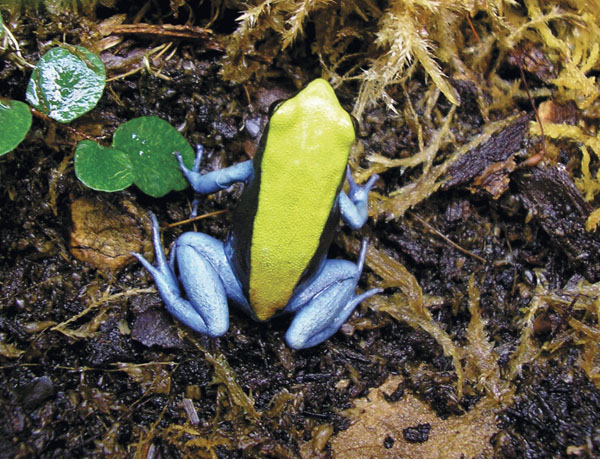
Photo Credit: Devin Edmonds
Highly desirable for its bright-blue legs and lemon-colored dorsum, Mantella expectata has colors that can fade during a simulated rainy season.
Although the overwhelming majority of mantellas found for sale are wild-caught, breeding does occur in captivity. Talk to people at a local herpetological society and search the Internet to locate the captive-bred species you are looking for.
Go Amateur or Pro
A standard 15-gallon aquarium lined with an inch of wetted sphagnum moss, a few pieces of cork bark, artificial plants and a small, shallow water bowl are sufficient for a group of six frogs. Moist paper towels can be used as an alternative to moss, but it must be changed frequently, sometimes daily, to ensure the frogs’ health. Sphagnum moss should be taken out and rinsed periodically, and replace it as needed.
Because of these frogs’ territorial behavior, provide sufficient hide spots, so all frogs feel secure. Artificial or live plants, pieces of cork bark, crumpled and moist paper towel, driftwood, or film canisters are all good options.
Alternatively, living terraria can be created to house mantellas. The bacteria and live plants in these systems help break down waste and minimize the amount of work needed to maintain them. It can be more difficult to monitor mantellas in these complex setups, but the aesthetics of a carefully designed terrarium outweigh this for some people.
A basic terrarium design consists of a drainage layer (gravel, LECA or a false-bottom of some sort), followed by nylon mesh. Several inches of soil and leaf litter are placed atop the mesh. Avoid potting soil because the added chemical fertilizers may irritate or harm mantellas. Instead, opt for a pre-mixed soil blend from a pet store or terrarium supply company. Tropical plants will grow well in this substrate, but remember to first rinse them thoroughly before placing them in the enclosure to remove pesticides. Use driftwood or cork-bark tubes to create dramatic effects and provide the frogs with places to perch.
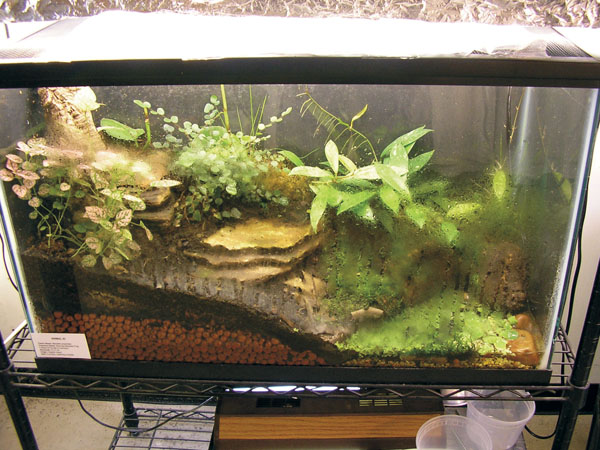
Photo Credit: Devin Edmonds
If live plants are grown within the enclosure, make sure the lighting provided does not overheat the cage.
Whether choosing a simple setup or living terrarium, a temperature range between 65 and 75 degrees works well. Some species, such as M. aurantiaca, M. cowani and M. crocea, are particularly sensitive to warm temperatures, and they quickly decline in health when exposed to them. Others, such as M. expectata and M. laevigata, prefer temperatures several degrees warmer than the aforementioned range. Daytime highs can reach nearly 80 degrees.
If live plants are grown within the enclosure, make sure the lighting provided does not overheat the cage. Allow the humidity level to remain high most of the time, particularly when temperatures are on the warmer side. Achieve this by using glass or plastic wrap to seal sections of a screen cover and misting the cage as needed. Some species from drier regions of Madagascar, such as M. expectata and M. viridis, may prefer less humid conditions than rain forest species, such as M. madagascariensis or M. nigricans.
Feeding Mantella Frogs
Mantellas have a tremendous appetite. Feed them small crickets, flightless fruit flies, termites, roach nymphs, small spiders, rice-flower beetle larvae, small waxworms and other available invertebrates.
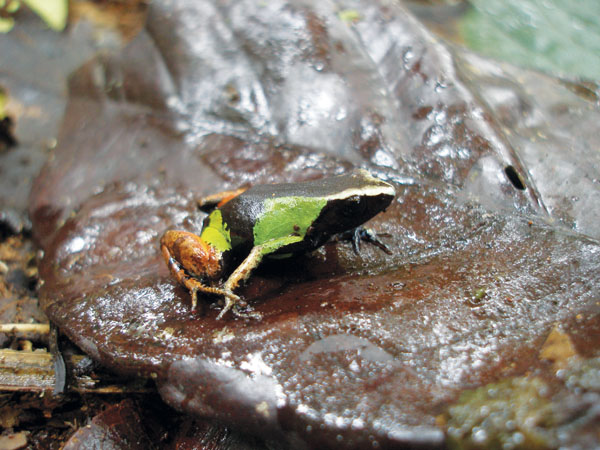
Photo Credit: Devin Edmonds
Mantellas such as this Mantella pulchra, have a tremendous appetite. Feed them small crickets, flightless fruit flies, termites, roach nymphs, small spiders, rice-flower beetle larvae, small waxworms and other available invertebrates.
Feed the frogs twice a week or in small quantities daily, and offer anywhere from two to 10 food items per frog depending on the kind and size of the feeders, and the frequency with which you feed the frogs. Use high-quality vitamin and mineral supplements so the frogs’ nutritional requirements are met. Alternately, use a calcium and multivitamin supplement lightly on food during most feedings.
A Dynamic Display
Acclimated, healthy mantellas make wonderful captives. Their fascinating behavior, and the bright contrasting colors and patterns of many species, make them an ideal candidate for the tropical terrarium. Male frogs engage in charming territorial conflicts involving calling and sometimes even physical combat depending on the species. Predominately diurnal, they spend much of the day hunting for food and patrolling their territory, and you can easily view this interesting behavior.

